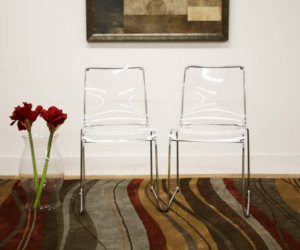
In the 1920s and 1930s, Germany’s Bauhaus school of design was at the forefront of modernist art and architecture.
This period is the birth of modernism, marking a significant shift from traditional decorative styles to functional, minimal designs.
Thus mid-century modern design influences started from this period in history, but as you might expect from the name, it’s not limited to just one country or culture.
The term “mid-century” generally refers to any popular design between 1940 and 1970, and it’s a wide range that encompasses many different styles and movements.
This style is still prevalent in mid-century modern furniture, and you can find it in many homes and offices.
The main goal was to eliminate unnecessary details and focus on clean lines that were both functional and beautiful simultaneously.
Thus mid-century furniture was often made with simple materials such as wood or metal, painted bright colors, or left plain white.
So, try the things below if you’re thinking of spicing up your living room, dining room, or even study with a classic mid-century look. Or you can check out Bandpass Design for more ideas.
Make use of lines and shapes.
When designing your mid-century modern space, look for lines and shapes in your furniture designs.
You can look for furniture with straight lines for items such as tables, chairs, and cabinets. Then find curved lines in areas like sofas and armchairs.
This goal is to achieve a sense of balance between different parts of the room so that everything looks uniform when viewed from afar or up close.
But it will still depend on where you place it in your house or apartment.
Another way to bring a bit of mid-century modern style into your home is by adding some new pieces with clean lines and geometric shapes.
For example, you can replace your traditional dining chairs with ones that have rounded edges instead of sharp corners will give your dining room a more modern appearance without going overboard on color or design elements.
You can also add contemporary accents like colorful pillows or artwork with bold geometric shapes.
Use accents
When using accents, you need to know what it is first.
An accent is an item that helps fill out a space or add visual interest without taking over the room.
It can be something as simple as a vase or picture frame or something more complex as a lighting fixture or rug, and it’s not just about color.
The key is to think about what things would make sense in the space and then feel outside the box.
For example, consider adding an accent piece like this fantastic yellow lampshade if you have a bedroom with primarily neutral colors and textures but need something bolder than just white walls and blue bedding.
Or, you can consider adding a different color to the wood, like an eye-catching design element, such as a brass knob or an attractive light fixture.
This will help break up the space while still keeping it cohesive.
If you are overwhelmed with how to use accents, you can start by adding a few pieces of furniture, such as a coffee table and a side table, that reflect the style of modern mid-century design.
Then, gradually add more details until you’ve created an entire space that feels like it came from the 1960s.
You can find fantastic vintage items on sites like Etsy or eBay to make it easier.
Play with patterns
You are free to play with patterns in your home if you plan to incorporate a mid-century modern design in your space.
Using patterns is one thing that makes mid-century modern so timeless.
You can paint them on walls or flooring instead of wallpaper. Patterns can make a bold statement or add subtle detail to a plain piece of furniture.
Remember that it’s not just about a single pattern. It’s about combining them in a way that looks natural and not contrived.
So you want your patterns to add depth and texture, not just be a distraction.
The best way to do this is to take natural inspiration. For example, you can look at leaves, flowers, or even animal skins and try to emulate their patterns in your home.
Embrace simplicity
Mid-century modern design is all about simplicity. The furniture pieces are clean and sleek, but they’re also exciting and give them their charm.
Most of them are wood, metal, or plastic and have a simple, geometric design. They’re not overly ornate or fancy, but just enough to make a statement without being overwhelming.
Mid-century modern furniture is also functional and affordable. So everyone can access these beautiful designs in their homes.
If you look at them closely, you will notice that most designs have their roots in Scandinavian design, which emphasizes simplicity in design and functionality.
Most mid-century modern designers are interested in creating furniture that would last generations rather than just looking suitable for a few years before being thrown out and replaced.
They also have an eye toward ergonomics, so you’ll find plenty of pieces that are easy on the eyes and comfortable to sit or sleep on.
Perhaps most importantly, though, is how versatile these pieces can be.
They look great in modern and retro spaces, so whether you’re trying to add some personality to your home or want something more timeless-looking for your office environment, there’s something here for everyone.
Choose the right color palette.
Choosing the right color palette for your mid-century modern furniture is essential in decorating with this style.
The colors you choose can complement or clash with the rest of your home, so it’s essential to take your time and find the right palette for each piece of furniture.
When choosing colors, think about how they will look under natural and artificial light. You’ll also want to consider how well the color will work with other hues in your home.
So, you may want to consider using neutral colors like white or black for some pieces but still use bolder colors for others so that they stand out against the backdrop.
Remember that these colors need to complement each other you do not select them randomly. This is integral to making the room feel cohesive and inviting.
Here are some tips for choosing the right colors:
The first thing to consider is how many different hues you want in your living room.
If you want a more subdued look, go with fewer colors, but if you want something bright and vibrant, go for more hues that complement each other.
Second, consider how much of each hue will be used in your furniture. For example, if you have a lot of blue in your room, add more green to make it pop.
Third, consider what kind of lighting will be used in the room.
If it’s not natural light coming through a window or skylight, choose lighter shades so they don’t appear too dark when lit up by artificial light sources such as lamps or overhead lights.
Make wooden furniture to celebrate craftsmanship.
Mid-century modern furniture is a celebration of craftsmanship. The furniture needs to last, and it needs to be beautiful.
So these pieces are often large in scale, with clean lines and a modern feel.
In addition, many of these pieces included accessories designed to add functionality and style to your home.
So, if you’re looking for a piece of mid-century modern furniture for your home, consider your available space before making a purchase.
Consider whether additional items will need added storage space or if you can use them as decorating accents instead of functional objects.
Final Thoughts
Mid-century modern design is popular today partly because of its distinct style but primarily due to its originality and ingenuity.
This particular style is highly desirable not only for its aesthetics but for the story behind it, which is so rich in culture.
In addition, the practical and efficient use of materials and up-to-date technology was groundbreaking and helped shape how designers created livable spaces.

